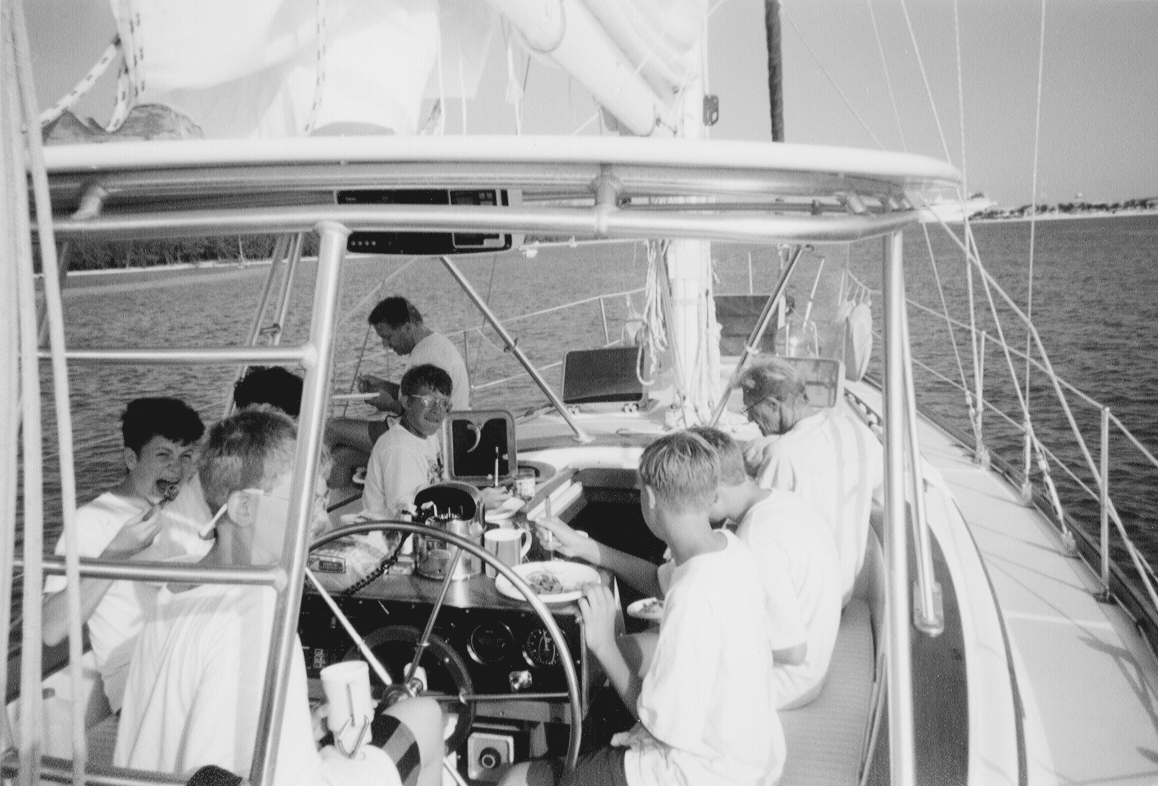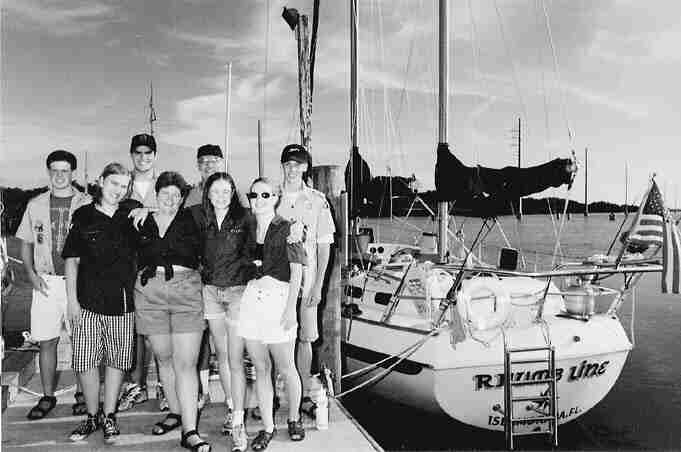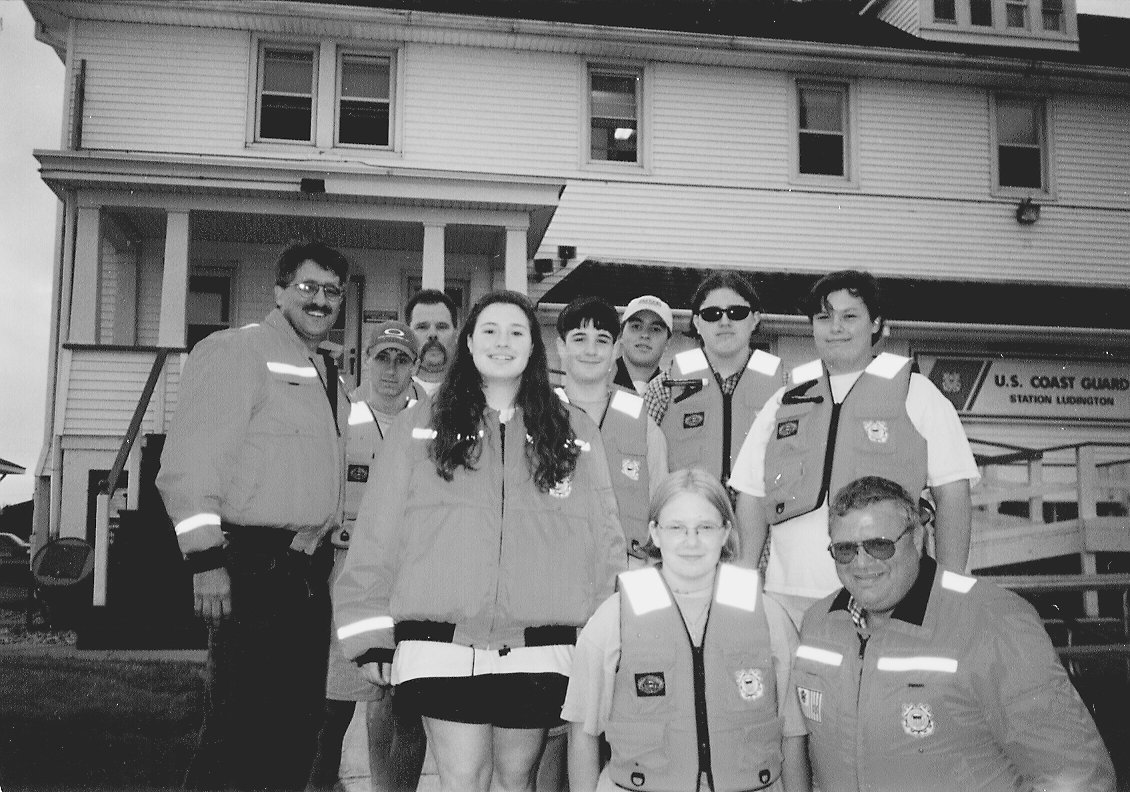 A first time for sailing and a sailing experience of a lifetime. That is what
several young adults talked about as a great sailing and lifetime opportunity, one they
universally hope to do again. The High Adventure Sailing program of the boy scouts is
about boys and girls learning and having fun in an ocean adventure. They sail a large
sailboat up and down the Florida Keys.
A first time for sailing and a sailing experience of a lifetime. That is what
several young adults talked about as a great sailing and lifetime opportunity, one they
universally hope to do again. The High Adventure Sailing program of the boy scouts is
about boys and girls learning and having fun in an ocean adventure. They sail a large
sailboat up and down the Florida Keys.
Marina Yoder, a Minnesota based sea scout had been on a catamaran but
never a large sailboat before the sea scouts.According to Marina, she saw everything. She
remembers how every scout on the boat had individual duties that taught them the basics of
sailing and how their tasks were based on teamwork. She said everyone cooperated and had
fun at their jobs. When the lessons were over the scouts were able to enjoy the sights and
beauty of the ocean like flying fish and beautiful blue waters. Everything they did had a
element of fun to it. She talked about the boats’ skipper, Captain Chris, who she
says, was funny, nice and a very good storyteller.

Kevin Schwartz, another Minnesota based Sea Scout, liked everything he
did. He learned a lot about sailing because he got to do "everything" that
needed to be done on the ship. He and his friends gained a lot of satisfaction from
steering the boat. "Some got it going pretty fast", he recalls with laughter.
Snorkeling in ocean water and seeing coral and fish of all different kinds was definitely
a highlight of his trip.
James Banholzer, a St. Paul scout was also aboard a "high
adventure sea boat." He said, "I had a great time, the whole thing was fun,
I’d recommend it to anyone." Cooking the fish they caught on the boat was a
highlight for James especially when he saw and learned how good the captain was at
teaching the scouts to prepare great tasting, freshly caught ocean fish.
The sea scouting programs’ purpose is to teach young adults enough
sailing skills, and give them enough hands on experience to become competent at sailing.
Each boat that goes out to sea has adult chaperones on board as well as the captain and
the scouts. The adults explained that this program gets the kids to do all the work
because that is how they learn. The captain, they said, teaches the scouts the basics of
sailing and managing a boat while at sea and then its up to the kids to make everything
work.
Every day the scouts had experience trimming and hoisting sails,
reading compasses, steering a course, learning the importance of anchor watches as well as
keeping the boat in tip top shape. Ron Schwartz, an adult leader, says the kids had many
different experiences that would develop skills of teamwork and leadership. When finished
with their sailing duties, scouts went swimming and snorkeling in the ocean. They earned
scouting patches for all their water activities. Dave Siebenhaler, from St. Paul’s
Indianhead Council, remembers his son Adam’s catch. The fish Adam was reeling in . .
. a five foot dolphin. . . was bit in half by a barracuda before it ever got in the boat.
According to John Hogg, district director in Grand Rapids, Michigan the
Luddington Sea Explorers have been active for several years. They are supported by the
Luddington Optimist Club and Luddington Yacht Club.The Luddington Yacht Club provides
sailing expertise. The Sea Explorer Ship has had several members achieve the Quartermaster
award, which is the highest award in the Sea Scouting program. It is equal to the Eagle
Rank in the Boy Scout program. Membership in the crew is male and female.
Wally Heinichen, formerly a US Coast Guard, now skipper of the Armada
Sea Scout ship in Chicago, has seen scouts use their achievement of Quartermaster rank to
become the skippers of boats as far off as the British Virgin Islands. Molly Fosnaucht, a
top scout in Chicago and the US recently earned the right to skipper a 52 foot boat in the
Caribbean.
The Sea Scouting Life
Chuck Modlin made it in the business world the old-fashioned way, by
hard work and half-hitches. And bowlines and sun sights and varnishing brightwork. Sure, a
formal education helped but so did the marlinespike seamanship, celestial navigation and
heavy weather sailing skills he gained as a teenage Sea Scout in Southern California.
Like most adults with Sea Scouting in their blood, Modlin credits the
program he joined in 1936 as a 15 year-old to have fun on the water with giving him
valuable self-confidence and lifetime skills. And like many, he has stayed involved as an
adult volunteer. He’s been "skipper" of a Sea Scout ship for over 45 years.
As a stockbroker in Los Angeles today, Modlin will tell you the value of Sea Scouting
hasn’t changed much in all that time. Its contribution to the individual and to
society, he believes, lie not so much in the mastery of maritime skills as in the
management abilities and leadership qualities Sea Scouts take with them into adulthood.
The boats, he says, are a bonus.
 "Sure, I love being out on the water and that’s what draws the
kids, but that’s not the main reason I’ve stayed involved," says Modlin,
who served in the Navy following his Sea Scout days and came back as an adult leader in
1953. "There are few programs that teach responsibility\ y the way Sea Scouting
does."
"Sure, I love being out on the water and that’s what draws the
kids, but that’s not the main reason I’ve stayed involved," says Modlin,
who served in the Navy following his Sea Scout days and came back as an adult leader in
1953. "There are few programs that teach responsibility\ y the way Sea Scouting
does."
At 78, Modlin ‘s kids have to work hard just to keep up with him.
He takes his teenage crew to sea as many as 60 days a year in a retired, World War
IL-vintage, 40-foot U.S. Coast Guard fireboat. The SSS Volunteer with her Sea Scout crew
sails frequently to Catalina Island and the Channel Islands off Santa Barbara, and has
ranged as far as San Francisco, Puget Sound and even to southeastern Alaska.
According to Jimmie Homberg, first female commodore of the Sea Scout
National Committee, it’s a sense of responsibility and accountability that parents
seem to want for their kids today, more so than at any time of sea scouting. Sea Scouting
. . . and other youth programs that put kids in uniforms . . . went into a slump during
the Vietnam era, Homberg says, and it didn’t help that only boys could join. That
changed in 1970 when the program went co-ed.
"Today the parents of a 14-year old barely remember Vietnam and
their kids are excited by the uniforms, says Homberg. "Now parents want their
teenagers involved in solid, structured programs like Sea Scouting.
But vessels like the SSSVolunteer or the 120-foot ex-Coast Guard cutter
Reliance that Sea Scouts operate in the San Francisco area are the exception, not the
rule. Most Sea Scout ships, which usually are sponsored by businesses, service clubs,
churches and other local organizations own small boats . . . typically a 25 foot cruising
sailboat . . . that have been donated to the group, Homberg says.
The ship she skippered for six years in Bryan, Texas, had several small
boats for lake sailing. The scouts in Ship 428, like most local units, raised their own
money for adventures that can range from simple canoe-camping trips to ambitious bare-boat
charters out of exotic ports in the Florida Keys, the Bahamas and other Carribean ports.
Generating support can become a learning experience as valuable as
navigation and piloting, Homberg says. But the key to a successful ship . . . and to the
future of Sea Scouting . . . is committed adult volunteers.
"Adults don’t have to sign on to be skippers," she says.
"We just need competent boaters who are willing to teach specific skills or to serve
as judges at Sea Scout rendezvous and regattas or to help the scouts to plan a long
cruise.
"We need boaters who are willing to take kids out on the water,
too." Homberg adds. "
These kids already know about boats and rules of the road.They know how
to act aboard a vessel and they take boating safety seriously."
Positive adult mentoring often turns Sea Scouts into lifelong boaters.
And as adults, Sea Scouts bring with them the kind of seamanship skills, safe boating
expertise and respect for the water that will serve recreational sailing well in the next
century.
Back
to Previous Issues
 A first time for sailing and a sailing experience of a lifetime. That is what
several young adults talked about as a great sailing and lifetime opportunity, one they
universally hope to do again. The High Adventure Sailing program of the boy scouts is
about boys and girls learning and having fun in an ocean adventure. They sail a large
sailboat up and down the Florida Keys.
A first time for sailing and a sailing experience of a lifetime. That is what
several young adults talked about as a great sailing and lifetime opportunity, one they
universally hope to do again. The High Adventure Sailing program of the boy scouts is
about boys and girls learning and having fun in an ocean adventure. They sail a large
sailboat up and down the Florida Keys.
 "Sure, I love being out on the water and that’s what draws the
kids, but that’s not the main reason I’ve stayed involved," says Modlin,
who served in the Navy following his Sea Scout days and came back as an adult leader in
1953. "There are few programs that teach responsibility\ y the way Sea Scouting
does."
"Sure, I love being out on the water and that’s what draws the
kids, but that’s not the main reason I’ve stayed involved," says Modlin,
who served in the Navy following his Sea Scout days and came back as an adult leader in
1953. "There are few programs that teach responsibility\ y the way Sea Scouting
does."